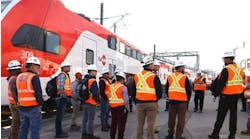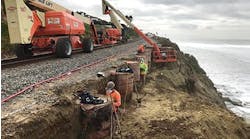The San Francisco Municipal Transportation Agency (SFMTA), which oversees all transportation in the city, announced a pilot safety enhancement project on Folsom Street between 4th and 11th streets. This proposed pilot project will increase bicycle and pedestrian safety and comfort by creating a buffered bicycle lane and reducing pedestrian crossing distances. These enhancements will be made possible by a lane reduction from four travel lanes to three.
“Enhancing our city's bicycle network ensures greater safety for not only bicyclists, but it helps us create roadways where different modes of transportation can coexist,” said Mayor Edwin M. Lee. “The buffered bicycle lane in this pilot will create a safer, less intimidating street while giving us an opportunity to study how measures like these can be implemented in dense and rapidly growing areas of San Francisco to make our city streets safer for everyone.”
“SoMa continues to grow rapidly with new residential and office development—meanwhile SoMa has the highest number of traffic collisions in the City. We must respond with strategic investments in transit infrastructure and traffic calming,” said San Francisco District 6 Supervisor Jane Kim. “Folsom Street is a key corridor unifying the SoMa neighborhood, connecting our residents from the Mission to downtown. This pilot project is critical to boosting safety and travel for both cyclists and pedestrians.”
The Folsom Street pilot project design originates from possible design options identified in previous SoMa area community outreach efforts. As part of the upcoming pilot project implementation, the SFMTA will hold a community meeting to discuss the project and conduct further community outreach.
“San Francisco’s SoMa area has experienced a 98 percent increase in bicycling since a SFMTA count taken in 2006 and Folsom Street is now the sixth busiest bicycle route in the city,” said Tom Nolan, chairman of the SFMTA board of directors. “With more people bicycling on Folsom Street and more people coming to live and work in the SoMa area overall, this pilot project will help us provide a safer travel experience for all roadway users.”
“Bicycle use is skyrocketing in San Francisco and we need to continue improving our roads to make them more safe and comfortable for those riding a bicycle and for all road users,” said Ed Reiskin, SFMTA director of transportation. “The Folsom Street pilot project will bring immediate benefits and will help us learn how to more effectively create safe streets in our downtown core where we see a mix of vehicle, pedestrian and bike traffic.”
“We are pleased to see the city moving forward on safety improvements to Folsom Street. The planned buffered bikeway, pedestrian improvements and traffic calming will certainly make it feel safer and less stressful for the huge numbers of people biking and walking along this key corridor. We hope this is the start of a greater focus on creating safer SoMa streets," said Leah Shahum, executive director of the San Francisco Bicycle Coalition.
With anticipated implementation by the end of 2013, the Folsom Street pilot project will allow the SFMTA to measure the change in travel volumes along the corridor, diversion of traffic, and right turns on adjacent parallel and cross streets. This pilot project will also help inform the Central Corridor Neighborhood Project Environmental Impact Report which is planned to be completed June 2015.
As complex complete street projects take time to design, environmentally clear and build, this pilot project on Folsom Street will make the road safer in the interim while also presenting the opportunity for further analysis.



